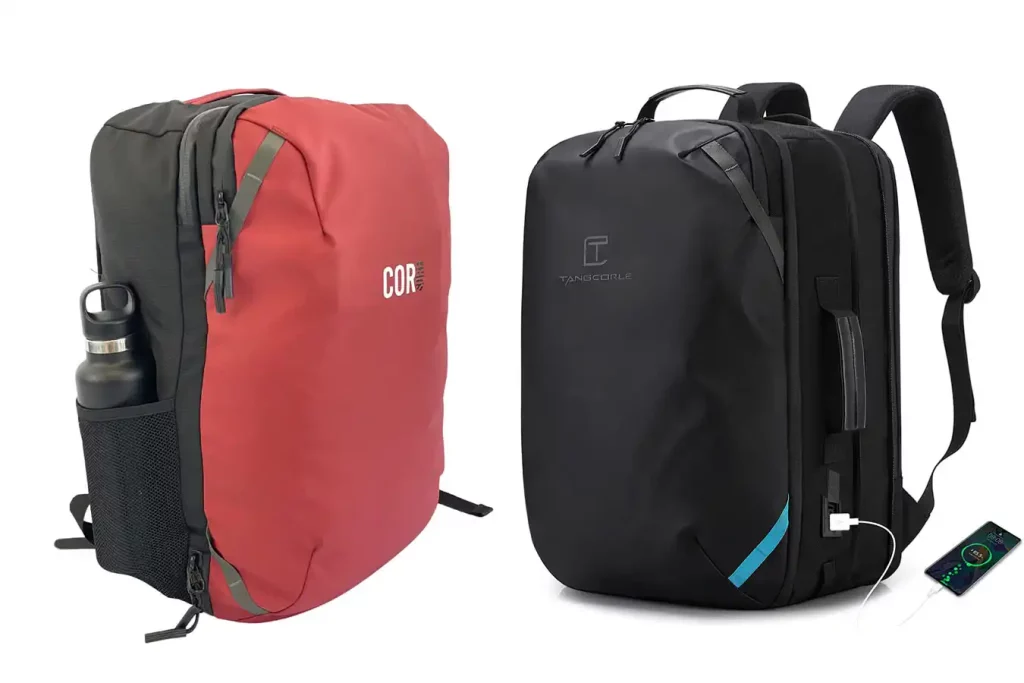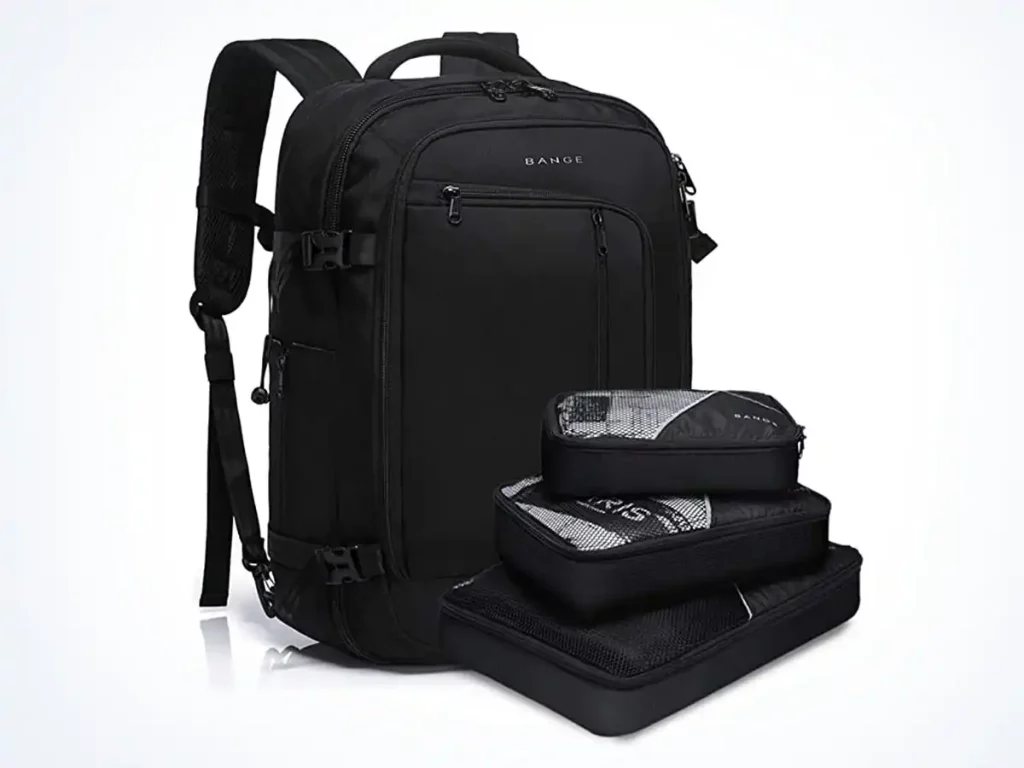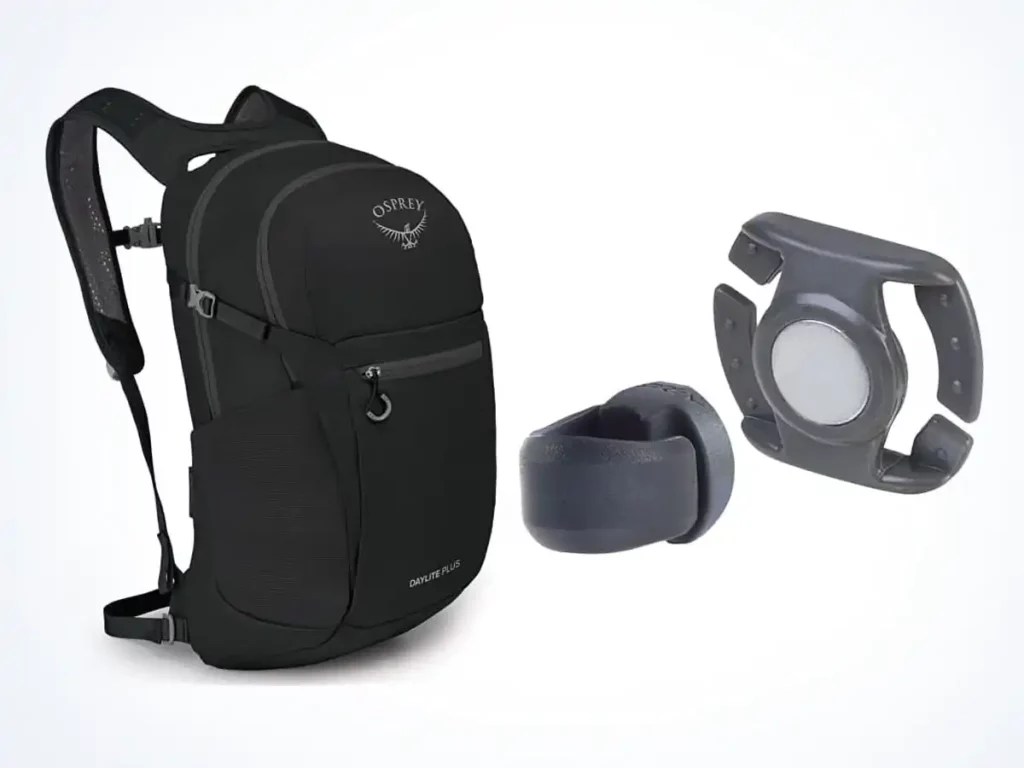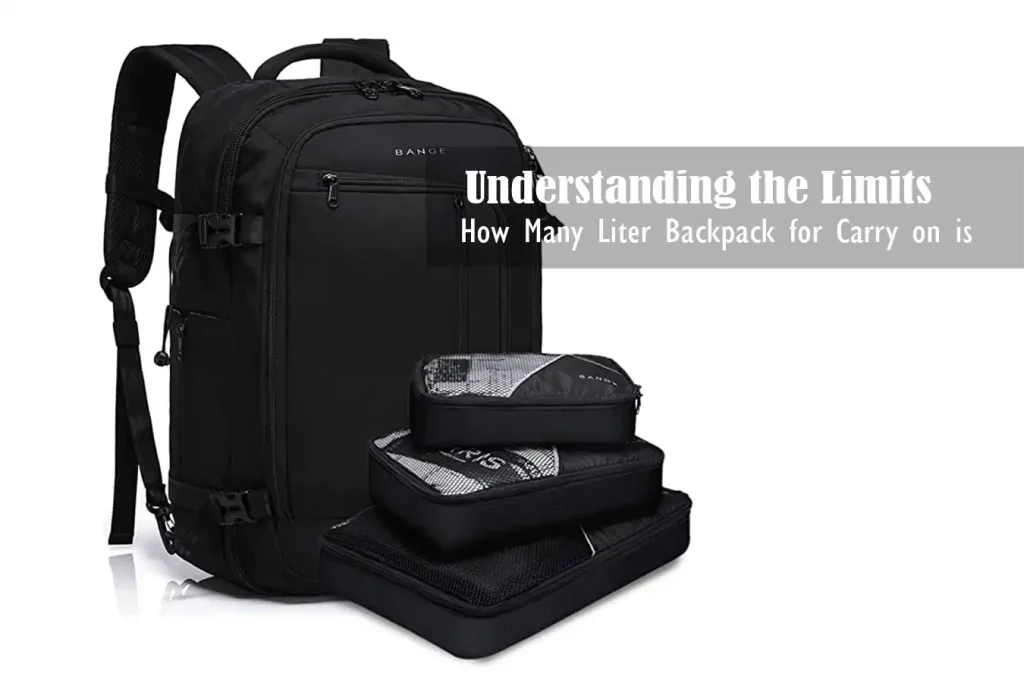“How many liter backpack for carry on” is the question on many travelers’ minds, right?
We’ve all been there, standing at the airport, wondering if our trusty backpack will pass the test.
It’s not just about fitting overhead; it’s about convenience and making the most of our journey.
Dive into this guide as we unravel the ideal backpack size for a hassle-free carry-on experience.
Say goodbye to size doubts and hello to savvy traveling! Ready to pack smarter!
Liter Backpack Size Guide: What Does It Mean?
Before we embark on our journey to find the perfect carry-on backpack, let’s first understand what we mean by ‘liter’ in the context of backpacks.

Explanation of ‘liter’ as a unit of measurement for backpacks
In the backpack industry, ‘liter’ refers to the volume or capacity of a backpack. Essentially, it’s a measure of how much stuff your backpack can hold.
This metric is derived from the backpack’s dimensions (length, width, and height). Just like a liter of water is a measure of volume, a liter in backpack terms measures the space inside your backpack.
But how does it translate into real-world scenarios? Well, imagine you have a backpack with a capacity of 20 liters. Technically, it means you could fit 20 one-liter bottles inside, assuming they could be perfectly arranged to fill every nook and cranny, which is usually not the case. In reality, the ‘liter’ figure gives you a baseline for comparing the capacity of different backpacks.
Common backpack sizes and their corresponding liter capacity
Backpacks come in a wide range of sizes, and the best one for you will depend on your specific needs. Here’s a quick breakdown of common backpack sizes:
- 15-30 liters: These are considered small to medium-sized backpacks. They are perfect for day trips or overnight journeys where minimal gear is required. They can typically fit some clothes, a small laptop or tablet, a book, and some snacks.
- 30-40 liters: These backpacks are the sweet spot for most travelers. They offer enough space for a few days’ worth of clothes, a larger laptop, a pair of shoes, and other travel essentials, while still being compact enough for carry-on restrictions.
- 40-50 liters: These are large backpacks designed for extended travel or specialized activities that require a lot of gear. They may be too big to be used as carry-on luggage on some airlines.
Remember, these are general guidelines, and the actual capacity you need will depend on various factors, like your packing style, the length of your trip, and the specific carry-on restrictions of the airlines you’ll be flying with. But understanding ‘liters’ in backpack sizes is the first step in choosing the perfect carry-on backpack.
Choosing the Right Backpack Size for Carry-On
Now that we understand what ‘liters’ mean in the context of backpacks and the common sizes available, let’s delve into how to choose the right size for your carry-on. Your choice will largely depend on the nature of your trip, your packing habits, and your personal preferences.
How to Choose a Backpack for Weekend or Short-Term Trips (15-30 liters)
Small to medium-sized backpacks, ranging from 15-30 liters, are an excellent choice for short-term trips like weekend getaways or business trips.
Benefits and Potential Drawbacks
These backpacks are lightweight and compact, making them easy to carry around airports, cities, or outdoor trails. They fit comfortably under the seat or in the overhead compartment of most airlines, eliminating the need to check in luggage and wait at baggage claim.
However, the smaller capacity might limit the amount of luggage you can carry. Overpackers, or those planning to bring back a lot of souvenirs, might find these backpacks constraining.
Ideal Use-Cases
A 15-30 liter backpack is perfect for minimalist packers going on a weekend trip or a short business trip where only essential items like a change of clothes, toiletries, and a laptop or documents are needed.
Mid-Sized Backpacks for Longer Journeys (30-40 liters)
For travelers embarking on a longer journey or those who prefer a bit more packing leeway, mid-sized backpacks in the range of 30-40 liters are ideal.

Advantages and Possible Limitations
With a 30-40 liter backpack, you have more space to pack additional clothing, a larger laptop, a pair of shoes, and other travel necessities. These backpacks still meet the carry-on size requirements for most airlines, making them convenient for travel.
The potential downside is that they are slightly heavier and bulkier than their smaller counterparts. While they still fit within most carry-on restrictions, some budget airlines might have stricter rules, so it’s essential to check in advance.
Perfect Scenarios
A mid-sized backpack is ideal for one to two-week trips, multi-destination vacations, or for travelers who prefer to have a little extra room for packing flexibility.
Larger Backpacks for Extensive Trips (40-50 liters)
For those planning extensive trips or specialized activities like camping or climbing, a larger backpack (40-50 liters) might be necessary.
Pros and Cons
The most significant advantage of a 40-50 liter backpack is its ample space, allowing you to pack multiple outfits, special gear, and bulky items. These are also typically built with more compartments and pockets for better organization.
The downside, however, is their size. They can be cumbersome to handle, especially when fully packed. Additionally, these backpacks may exceed carry-on size limits for some airlines, leading to potential check-in luggage fees.
Suitable Circumstances
A large backpack is suitable for long-term travelers, outdoor enthusiasts needing to carry specific gear, or for those who simply prefer to have a lot of packing space.
Choosing the right backpack size for your carry-on isn’t one-size-fits-all but is about understanding your specific needs and aligning them with the right liter capacity.
In short, the optimal size for a carry-on backpack is typically between 30 to 40 liters, which provides sufficient space for travel essentials while adhering to most airline restrictions for cabin luggage.
Here’s an example of a simple Backpack Size Chart that outlines the typical liter capacity for different travel scenarios:
| Backpack Size (Liters) | Ideal For | Examples of Items to Carry |
| 15-30 Liters | Day trips, everyday carry, light packing for a weekend | Essentials like wallet, keys, phone, laptop, a change of clothes, a book or e-reader, compact camera, snacks, water bottle |
| 30-40 Liters | Multi-day trips, winter day trips, minimalist packing for a week | All of the above plus extra layers of clothing, a compact sleeping bag or hammock, small cooking gear, larger camera equipment |
| 40-50 Liters | Week-long trips, adventure trips requiring more gear | All of the above plus more clothing, more substantial food and cooking equipment, larger sleeping bag and pad, climbing gear or other sports equipment |
It’s worth noting that this chart provides general guidance and the exact needs may vary based on individual requirements, the specific activities you plan to engage in, and even the weather conditions. As always, it’s best to tailor your choice based on your unique situation and needs.
Other Factors to Consider When Choosing a Carry-On Backpack
While liter capacity is a critical factor in choosing the right backpack for carry-on, several other factors come into play that you should not overlook. Let’s discuss these aspects and their significance in your decision-making process.
The Role of the Backpack’s Shape and Design in Airline Approval
Airline carry-on regulations are not only about the weight and liter capacity of the bag but also about its dimensions. For a backpack to fit in the overhead compartment or under the seat, its design and shape matter significantly. Backpacks with a slim profile and those without extended pockets or sections are more likely to be airline-friendly.
Moreover, backpacks designed with travel-specific features, such as lockable zippers, a padded laptop compartment, or a lay-flat design for easy TSA scanning, can add to your travel convenience.

Importance of the Backpack’s Weight When Empty
An often-overlooked aspect when choosing a backpack is its weight when empty. Heavier materials may offer more durability but can quickly eat into your weight allowance, especially when flying with airlines with strict carry-on policies. Lighter backpacks made from strong, lightweight materials give you the leeway to pack a bit more without exceeding weight restrictions.
The Versatility and Organization of the Backpack
Look for a backpack that offers versatility and organization. Features such as adjustable straps, multiple compartments, and pockets for small items can enhance usability. A versatile backpack is especially useful if you plan to use it for various purposes, like hiking, skiing, working, or sightseeing, during your trip.
Top Backpack Recommendations for Carry-On
In this section, we’ll recommend some top backpacks in each size category. These backpacks stand out for their quality, durability, and thoughtful design.
15-30 liters Backpack Recommendations
- Osprey Daylite Plus (Amazon)- This compact and lightweight 20-liter backpack is perfect for short trips, with a padded laptop sleeve and a front pocket for small items.
- Deuter Speed Lite 21 (Amazon) – Ideal for weekend adventures, this 21-liter backpack has a lightweight, athletic design with plenty of pockets for organization.

30-40 liters Backpack Recommendations
- YETI Crossroads Backpack 35L (Amazon) – This versatile 35 liters backpack expands to accommodate more items, perfect for travelers who need a bit more space.
- Osprey Farpoint 40 (Amazon) – With a 40-liter capacity, this backpack is designed for longer trips. It features a laptop sleeve and plenty of organizational pockets.
40-50 liters Backpack Recommendations
- Deuter Aircontact Lite 45+10 Sl (Amazon)- This 45-liters backpack offers ample storage, adjustable straps, and extra volume for extensive trips.
- Osprey Atmos AG 50 (Amazon) – This 50-liter backpack is perfect for multi-day hikes or long-term travel, with an AntiGravity™ suspension system for carrying comfort.
Remember, when choosing the right backpack for your carry-on, consider your travel needs, backpack design, and airline restrictions. With the right bag, you’ll make your travel experience smoother and more enjoyable.
Learn more: How Much Weight Can a Backpack Hold
Practical Tips for Packing a Carry-On Backpack Efficiently
Once you’ve chosen the right backpack for your carry-on, knowing how to pack efficiently can make a world of difference. It’s not just about what you pack, but how you pack it. Here are some practical tips to maximize space and ensure a smooth journey.
Maximizing Space in Your Backpack
When it comes to packing a backpack, strategic arrangement is key. Start by laying out all your items so you can see what you have. Next, pack in layers. Start with bulky items at the bottom, lighter clothes in the middle, and leave the top and front pockets for items you need to access quickly. Utilizing packing cubes can help organize your items and compress them to take up less space.
Consider rolling your clothes instead of folding them. Rolled clothes take up less space and tend to wrinkle less. Make sure to fill the nooks and crannies. For example, shoes make a great place to pack socks or other small items.
Essentials to Always Include in Your Carry-On
While the specifics might vary depending on your destination and the nature of your trip, there are some essentials you should always include in your carry-on backpack.
These include travel documents, passport, money, phone, chargers, a change of clothes, essential toiletries (within liquid restrictions), snacks, and any prescribed medication. It’s also a good idea to pack a lightweight jacket or sweater, even if you’re heading to a warm destination, as flights can be chilly.
Tips for Quick Airport Security Checks
Airport security checks can be a breeze if you pack your carry-on backpack with this in mind. Keep your travel documents and identification handy, perhaps in an easy-to-access pocket of your backpack.
If you’re carrying a laptop or any other large electronics, make sure they’re easy to take out and put back in. The same goes for your liquids bag. Remember, all liquids should be in containers of no more than 100ml and packed in a single, transparent, resealable plastic bag.
To know more: How to Pack a Backpack for Hiking
FAQs About How Many Liter Backpack for Carry on
Can You Take a 40L Backpack as a Carry-On?
Can You Take a 30L Backpack on a Plane?
Can a 45L Backpack be a Carry-On?
How Big of a Backpack Can You Use as Carry-On?
Final Thoughts
Choosing the right size of backpack for your carry-on isn’t a one-size-fits-all scenario. It’s a decision that depends on many factors including your travel duration, activities, and personal preferences.
From understanding liter capacities, to evaluating design and weight, and finally making the most out of your packing skills, we hope this guide has been helpful to make an informed choice.
Remember, the perfect backpack is one that caters to your needs, passes airline restrictions, and ultimately, makes your travel experience smoother. So, embrace the joy of travel, explore new places, and let your carry-on backpack be a trusty companion in your journeys!


